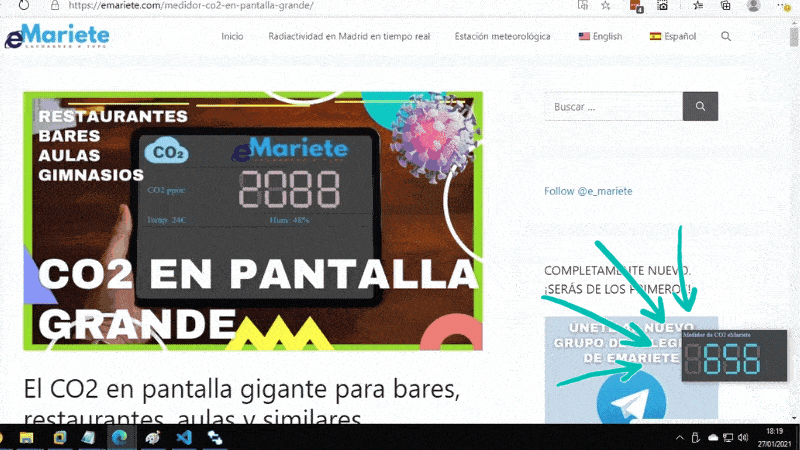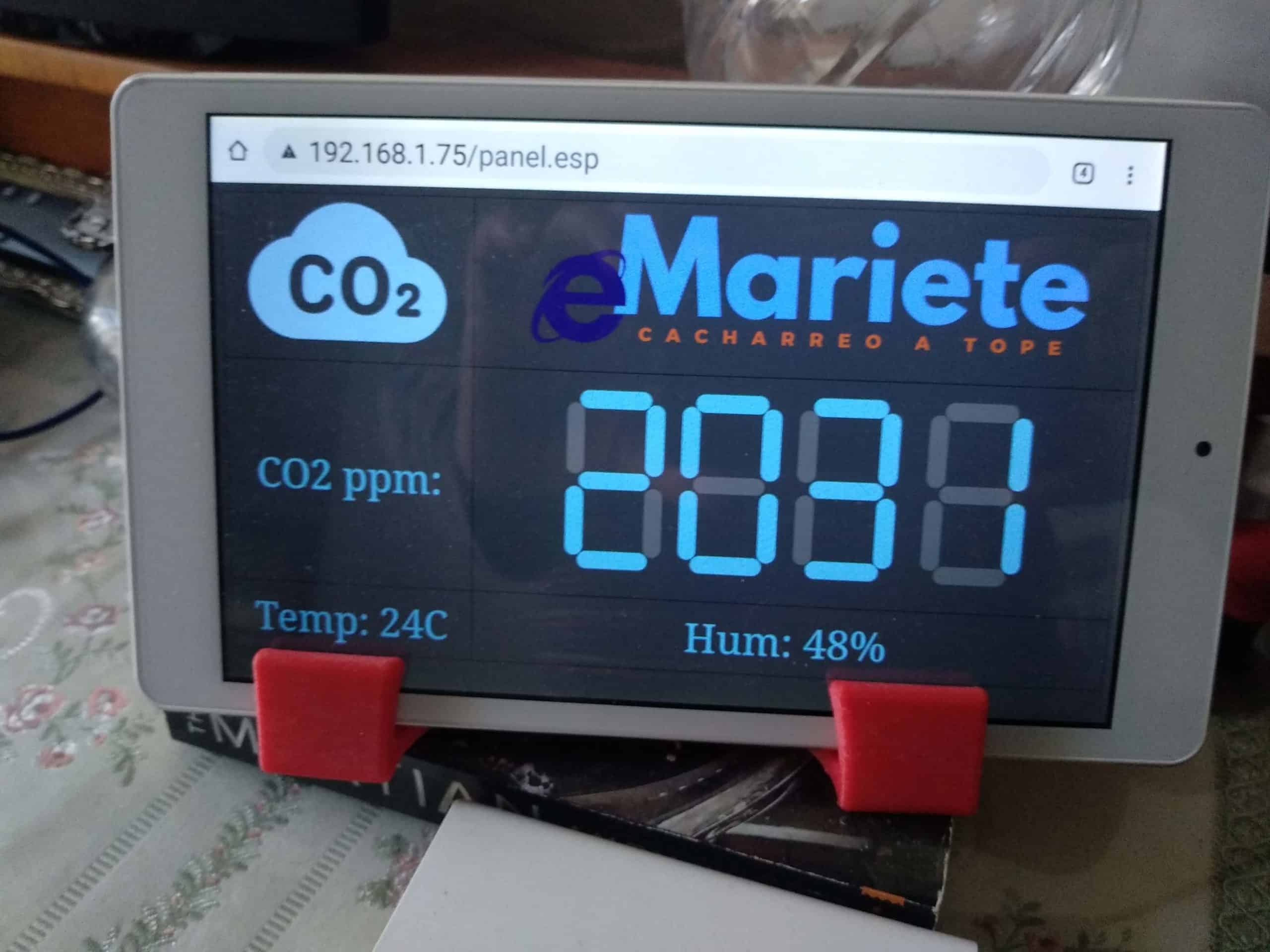There are many people who are looking for a CO2 meter with large display that can be seen from a distance for installation on catering, schools, gymnasiums and the like.
The truth is that the system is so flexible which, as you will see below, not only allows for the creation of huge display panels (from 5″ mobiles to 7″ tablets, 12.9″ iPads up to 100″ Smart TVs), but it is possible to create extremely small screens, like the floating teacher window I show below.
During this time I have carried out various prototypes and experiments with different types of displays. I have used large seven-segment LED displays, matrix panels, addressable panels, etc.
The problem I was facing was, on the one hand, the rigidity (each person has different tastes and needs and it would have been necessary to adapt the system to many different types of hardware) on the other hand the construction difficulty and the cost.
Finally, I said to myselfwhy not take advantage of the fact that the CO2 meter has a complete integrated web server and use it for display on all types of screens??
Said and done, I rolled up my sleeves, I got to work and today I bring you the result...
It's not finished yet, but I want to give you a taste of what's to come.
My knowledge of CSS (I know my way around it, but I haven't mastered it) makes it go slower than I would like, and gives me a lot more work than necessary.
If you have CSS knowledge and want to collaborate, please write me through the Telegram group. With a little help we can achieve something very, very attractive and interesting and many people in need will be able to benefit from it.

Benefits of CO₂ on the big screen
Being based on HTML, CSS, and JavaScript (the web technologies)There are many benefits to be gained from this large screen display system.
Apart from the obvious benefit, which is possible viewing information remotelywe would have the following:
- Great flexibility content and design
- No investment. There is no need to no more than the homemade CO₂ meter on this blog (and the device where you want to display it, of course).
- Adaptable to all types of devices (Phones, tablets, computers, Smart TV, etc.).
- Possibility of design responsive (self-adaptation to the display device).
- Multiple simultaneous clients.
- Possibility of integrating other sources of information.
- Complete freedom of choice colours, sizes, fontsetc.
- System fully autonomous (no internet connection required)
- No library dependencies such as jQuery or others.
- Customisable logo (I take everything) easily.
- Possibility to define several pages with different layouts.
Possibilities of the CO₂ meter on large display
Although, for the time being, it is only a prototype (I will soon publish instructions and the necessary filesOn this page, so that you can do the same), the visualisation system already has the following functionalities:
- Display of any parameter emissions from the CO₂ meter (such as temperature and humidity, in these examples).
- Real-time visualisation without reloading the page.
- Display of historical graphs (from Thingspeak or others).
- Colour changeaccording to the level of CO₂ (traffic light effect) with user adjustable levels.
- Possibility of displaying external data.
Of all of them, which will be useful to one person or another, I think that the most interesting and useful for everyone is that the display always shows the current CO₂ value. You don't need to reload the page or press any buttons to get the current data.
Display devices
There are many devices on which CO2 visualisation is possible. Whether you need a small stand-alone system, with a tablet, for example, for medium-sized spaces such as a Large format TV, for large venuesyou always have a choice.
Tablets
The tablet is the display device par excellence.
There are really cheap Android tablets, even older tablets, that you may not use anymore, that you can use for this, giving them a new youth.
They are ideal to put them on fixed to the wall with some kind of bracketlike this one:
No products found.
Smart TV
Most Smart TVs in recent years support HTML, CSS and JavaScript (internet technologies) so it will be very easy to use them as a CO₂ display device.
This is a perfect solution for really big rooms where we need information to be seen from all points.
We can put a SmartTV from 4K and 58″for relatively little money than will be seen from far away.
No products found.
regular TVs (with the help of, for example, an Amazon Fire TV Stick)
If you have a slightly older television, or any monitor with HDMI inputYou can use it to display CO₂ levels using, for example, a Fire TV Stick:
No products found.
Teams of teacher, monitor, supervisor, etc.
It's not all giant screens. Sometimes the essence comes in a small bottle.
Sometimes it is important that the teacher, monitor, supervisor, etc. have the possibility to see permanently the level of CO₂ in the environment.
In this image (bottom right) you can see how a small window "floats" on the teacher's computer over and above what he or she is doingallowing you to view the CO₂ level at all times. The teacher can drag the window to relocate it, resize it and, of course, hide it.

Limitations
As with everything else, this system also has its limitations.
These are the ones I know of so far (if you discover another one let me know so I can include it).
- Low security: Not valid if you want to show "sensitive" data. It is intended for public data, so you don't care if someone, in whatever way, connects and gets it.
- Concurrent users: The microcontroller used in the CO₂ meter (ESP8266) is not a real web server, so it won't support many connections at once. I have tested it with four simultaneous connections and it works, but I don't know how many it would support. This is intended for connecting a few display devices, not for a bunch of people connecting to the CO₂ meter directly.
Examples of visualisation
I will leave you here some examples of what I am doingto give you an idea:
Recommended Tablets
Almost any tablet should do as a display device. Of course, there are so many models that it is difficult to know a priori whether any of them will not work for some reason.
Most importantly, when used as a display device is the tablet is capable of being on and charging simultaneously. Almost all of them do, but not all, I, for example, have one that, even if it is plugged inThe battery consumes more than it charges, so after a few hours it shuts down.
I recommend that you buy your tablet from Amazon, where you will be able to return it and exchange it for another one if it does not work, without any problem.
Here are some of Amazon's best-selling tablets:
No products found.
If you use any tablet sold on Amazon (whether it is included in this list or not) let me know, with the results obtained, so that I can advise users.



Hello,
Lately I follow your blog day by day. I am a teacher and I am about to start the CO2 meter project, with students. From what I can see in an image, it seems that you use Thingspeak to publish the sensor readings, I have tried but I have not been able to do it, I have just discovered ESPeasy and I still do not understand the platform well, nor MQTT. However, with Arduinoblocks I haven't had any problems. Could you point me to a tutorial to connect to Thingspeak? I don't think I'll have problems if it's in English.
I also noticed in the MH-Z19B video that there doesn't seem to be much difference between the results of the original MH-Z19B and the reference Senseair, right?
Greetings, and thank you very much for all the work you do and show us.
Thank you
Edit:: Checking the blog, I saw some instructions on the entry https://emariete.com/medidor-casero-co2/#Creacion_de_grafico_de_evolucion_de_CO so I will try to see what I can do.
Thank you very much.
Hello Alberto.
I'm glad you found the instructions on how to send the data to Thingspeak.
The differences between the measurements of the MH-Z19B and the Senseair S8 LP are not big, both sensors measure quite well. The Senseair S8 LP is faster at detecting changes.
If you have any questions, I'll be happy to help you. The best way is through the Telegram group: https://t.me/emariete_chat
Best regards.
Hi, can you please post at least the basics to be able to view the data on a tablet? Even if it's just the real time value! Thank you very much for the work! Best regards
Hello Jordi.
We are just taking it up again, with the help of our colleague Sey. Let's see if we can give it a good push and publish it soon.
Best regards.
Hi, how is this project going. I would like to try it out for my premises.
It seems to me that they are going to make it compulsory.
I've ordered the parts to start assembling it. I'll keep you posted with my problems 🙂
Best regards.